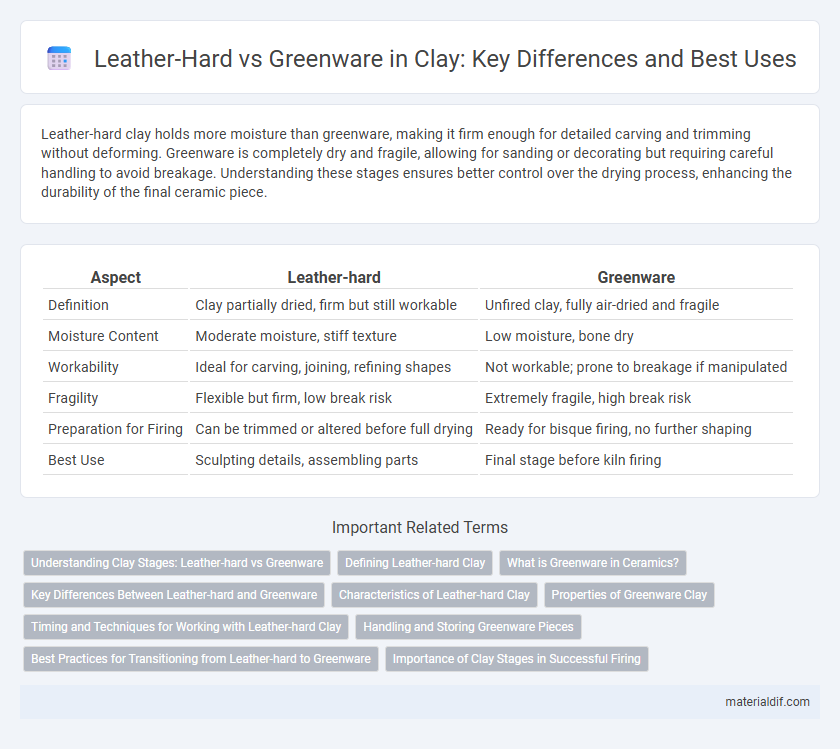Leather-hard clay holds more moisture than greenware, making it firm enough for detailed carving and trimming without deforming. Greenware is completely dry and fragile, allowing for sanding or decorating but requiring careful handling to avoid breakage. Understanding these stages ensures better control over the drying process, enhancing the durability of the final ceramic piece.
Table of Comparison
| Aspect | Leather-hard | Greenware |
|---|---|---|
| Definition | Clay partially dried, firm but still workable | Unfired clay, fully air-dried and fragile |
| Moisture Content | Moderate moisture, stiff texture | Low moisture, bone dry |
| Workability | Ideal for carving, joining, refining shapes | Not workable; prone to breakage if manipulated |
| Fragility | Flexible but firm, low break risk | Extremely fragile, high break risk |
| Preparation for Firing | Can be trimmed or altered before full drying | Ready for bisque firing, no further shaping |
| Best Use | Sculpting details, assembling parts | Final stage before kiln firing |
Understanding Clay Stages: Leather-hard vs Greenware
Leather-hard clay is partially dried and firm enough to handle without distortion, ideal for trimming and attaching pieces, while greenware refers to unfired clay at its most fragile and fully air-dried stage. Greenware is highly susceptible to cracking and must be carefully handled and dried before firing. Understanding these stages is crucial for successful sculpting, ensuring that structural integrity is maintained throughout the creation process.
Defining Leather-hard Clay
Leather-hard clay describes a stage in the clay drying process where the material retains enough moisture to be firm yet still slightly pliable, allowing for carving and attaching pieces without deformation. This stage contrasts with greenware, which is fully unfired and completely raw clay that is soft and fragile, prone to damage from handling. Understanding the leather-hard phase is essential for sculptors aiming to refine details or join components before the clay transitions to bone dry and ultimately bisque firing.
What is Greenware in Ceramics?
Greenware in ceramics refers to clay pieces that have been shaped and are completely dry but have not yet undergone firing. At the leather-hard stage, clay holds some moisture and is firm enough to handle without deformation, whereas greenware is fully dried and extremely fragile. Proper handling and drying of greenware are critical to prevent cracks or breakage before bisque firing.
Key Differences Between Leather-hard and Greenware
Leather-hard clay is partially dried and firm enough to hold its shape, making it ideal for carving or joining pieces, while greenware refers to completely unfired clay that is still fragile and retains moisture. The primary difference lies in moisture content; leather-hard clay contains enough water to be workable but is no longer pliable, whereas greenware is more delicate and can easily break during handling or transport. Understanding the distinct stages of clay helps potters optimize their techniques for sculpting, trimming, and preparing pieces for firing.
Characteristics of Leather-hard Clay
Leather-hard clay exhibits a firm yet slightly pliable texture, making it ideal for carving, trimming, and assembling pieces without deformation. Its moisture content is lower than greenware, providing sufficient rigidity while retaining enough plasticity for detailed work. Unlike the fragile and easily breakable greenware, leather-hard clay maintains structural integrity, allowing artists to refine shapes and join parts before the drying and firing processes.
Properties of Greenware Clay
Greenware clay exhibits a fragile and porous structure, making it highly susceptible to breakage and moisture absorption before firing. Its low mechanical strength requires careful handling to prevent deformation or cracking during drying. This stage represents unfired pottery that still retains all organic components, which burn off during the bisque firing process.
Timing and Techniques for Working with Leather-hard Clay
Leather-hard clay, which is partially dried but still pliable, offers an optimal timing window for refining details, trimming, and joining pieces without compromising structural integrity. Working with leather-hard clay requires precise techniques such as scoring and slipping to ensure strong bonds during assembly and careful carving to enhance texture without causing cracks. In contrast, greenware, being fully wet and fragile, demands more delicate handling and is less suitable for intricate modifications or support during construction.
Handling and Storing Greenware Pieces
Greenware pieces, being unfired and highly fragile, require careful handling to avoid cracks or breakage during storage. Store greenware in a cool, dry place with consistent humidity, placing them on padded surfaces to cushion against vibrations or accidental impacts. Avoid stacking pieces directly to prevent deformation, allowing ample airflow to facilitate even drying and reduce the risk of warping.
Best Practices for Transitioning from Leather-hard to Greenware
Transitioning from leather-hard to greenware requires careful drying to prevent warping and cracking, emphasizing consistent humidity levels and gradual air exposure. Best practices include maintaining a slow, even drying environment, using plastic covers or damp cloths to control moisture loss, and handling pieces minimally to preserve structural integrity. Monitoring clay moisture content and adjusting drying time based on thickness ensures optimal strength before firing.
Importance of Clay Stages in Successful Firing
Leather-hard clay holds crucial structural integrity necessary for carving and assembling without deformation, reducing risks like warping during firing. Greenware, being fully dried but unfired, is extremely fragile and must be handled carefully to avoid cracks or breakage before the bisque firing stage. Understanding these clay stages ensures controlled moisture content, leading to successful firing results and durable ceramic pieces.
Leather-hard vs Greenware Infographic

 materialdif.com
materialdif.com